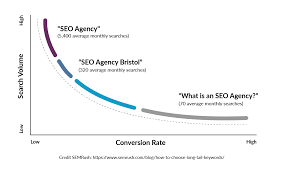The Power of Longtail SEO
In the world of search engine optimisation (SEO), longtail keywords play a crucial role in driving targeted traffic to your website. While short, generic keywords may attract a large volume of searches, longtail keywords offer a more specific and focused approach that can lead to higher conversion rates and better engagement with your audience.
Longtail keywords are longer and more specific phrases that users are likely to search for when they are closer to making a purchase or seeking detailed information. For example, instead of targeting the keyword “shoes,” a longtail keyword could be “best running shoes for women with high arches.”
By incorporating longtail keywords into your SEO strategy, you can tap into niche markets and reach potential customers who are actively looking for what you have to offer. These keywords often have lower competition levels, making it easier for your website to rank higher in search engine results pages.
Furthermore, longtail SEO can help you create content that is more relevant and valuable to your target audience. By addressing specific needs and answering detailed questions, you can establish yourself as an authority in your industry and build trust with your visitors.
When implementing longtail SEO, it’s essential to conduct thorough keyword research to identify relevant phrases that align with your business goals. You can use tools like Google Keyword Planner, SEMrush, or Ahrefs to discover high-quality longtail keywords that have decent search volume and low competition.
In conclusion, longtail SEO offers a powerful way to enhance your online visibility, attract qualified leads, and improve the overall performance of your website. By focusing on longtail keywords that resonate with your target audience, you can drive organic traffic and achieve sustainable growth in the competitive digital landscape.
Mastering Longtail SEO: 6 Essential Tips for Enhanced Search Visibility
- Focus on specific, niche keywords relevant to your target audience
- Create high-quality, in-depth content that addresses the needs of users searching for long-tail keywords
- Optimize meta tags and headings with long-tail keywords to improve search engine visibility
- Build internal links within your website to connect related long-tail content
- Utilize tools like Google Keyword Planner or SEMrush to research and identify effective long-tail keywords
- Monitor and analyse performance regularly to refine your long-tail SEO strategy
Focus on specific, niche keywords relevant to your target audience
When implementing longtail SEO, it is crucial to focus on specific, niche keywords that are highly relevant to your target audience. By honing in on these specialised phrases, you can effectively reach potential customers who are actively seeking the products or services you offer. Tailoring your content to address the specific needs and interests of your audience not only improves your search engine rankings but also enhances user engagement and conversions. This targeted approach ensures that your website attracts qualified leads and establishes a strong connection with those most likely to convert into loyal customers.
Create high-quality, in-depth content that addresses the needs of users searching for long-tail keywords
Creating high-quality, in-depth content that directly addresses the specific needs and queries of users searching for long-tail keywords is a fundamental tip in longtail SEO strategy. By providing valuable and detailed information that fulfills the intent behind these longer search phrases, you not only improve your chances of ranking higher in search engine results but also establish credibility and trust with your target audience. This approach not only attracts more qualified traffic to your website but also enhances user engagement and encourages repeat visits, ultimately contributing to the overall success of your SEO efforts.
Optimize meta tags and headings with long-tail keywords to improve search engine visibility
To enhance your search engine visibility through longtail SEO, it is crucial to optimise your meta tags and headings with specific long-tail keywords. By incorporating these targeted phrases into your meta tags and headings, you can signal to search engines the relevance of your content to users’ search queries. This strategic approach not only improves the chances of your website ranking higher in search results but also attracts more qualified traffic that is actively seeking the information or products you provide.
Build internal links within your website to connect related long-tail content
Building internal links within your website to connect related long-tail content is a valuable tip in longtail SEO strategy. By strategically linking relevant longtail keywords and articles within your site, you can create a network of interconnected content that not only enhances user experience but also signals to search engines the relevance and depth of information on your website. This practice not only helps users discover more valuable information but also boosts the authority and visibility of your longtail content, ultimately improving your overall SEO performance.
Utilize tools like Google Keyword Planner or SEMrush to research and identify effective long-tail keywords
To maximise the impact of your longtail SEO strategy, it is advisable to leverage powerful tools such as Google Keyword Planner or SEMrush. These tools offer valuable insights and data that can help you research and pinpoint highly effective long-tail keywords tailored to your specific niche. By utilising these tools, you can uncover hidden opportunities, understand search trends, and ultimately enhance the visibility and relevance of your website in search engine results.
Monitor and analyse performance regularly to refine your long-tail SEO strategy
Monitoring and analysing the performance of your longtail SEO strategy on a regular basis is essential for achieving optimal results. By tracking key metrics such as keyword rankings, organic traffic, conversion rates, and user engagement, you can gain valuable insights into what is working well and where improvements are needed. This data-driven approach allows you to refine your longtail SEO strategy over time, ensuring that you stay ahead of the competition and continue to attract qualified leads to your website.

